ELITE TUTORING
Elite Tutoring is your ultimate destination for academic success. I offer a curated selection of high-quality study tools designed to enhance your learning experience and boost exam performance. From comprehensive study guides and interactive practice exams to expert-recommended resources, I provide everything you need to excel. Trust Elite Tutoring to turn your academic challenges into triumphs and help you pass your exams with confidence.
- 69
- 0
- 5
Community
- Followers
- Following
74 items
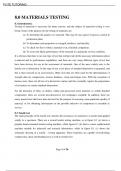
MATERIAL TESTING
The document outlines essential concepts in material testing, crucial for understanding material properties in material science. It covers various testing methods, including tensile, compressive, hardness, and impact tests. Detailed explanations of test procedures, equipment used, and the significance of each test in determining material behavior under different conditions are provided. Practical examples demonstrate how material testing ensures quality, reliability, and suitability for specific...
- Summary
- • 26 pages •
The document outlines essential concepts in material testing, crucial for understanding material properties in material science. It covers various testing methods, including tensile, compressive, hardness, and impact tests. Detailed explanations of test procedures, equipment used, and the significance of each test in determining material behavior under different conditions are provided. Practical examples demonstrate how material testing ensures quality, reliability, and suitability for specific...
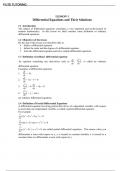
ORDINARY DIFFERENTIAL EQUATIONS
The document provides an overview of ordinary differential equations (ODEs), fundamental in modeling dynamic systems. It explains the basic types, including first-order, second-order, linear, and nonlinear ODEs. Key methods for solving ODEs, such as separation of variables, integrating factors, and numerical techniques, are detailed. The notes emphasize the importance of initial conditions and solutions' uniqueness. Real-world applications in physics, engineering, and biology illustrate the pra...
- Book
- Summary
- • 154 pages •
The document provides an overview of ordinary differential equations (ODEs), fundamental in modeling dynamic systems. It explains the basic types, including first-order, second-order, linear, and nonlinear ODEs. Key methods for solving ODEs, such as separation of variables, integrating factors, and numerical techniques, are detailed. The notes emphasize the importance of initial conditions and solutions' uniqueness. Real-world applications in physics, engineering, and biology illustrate the pra...
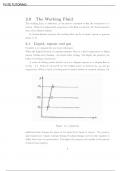
THE WORKING FLUID
The document explores the role of working fluids in thermodynamics, essential for transferring energy in thermal systems. It details properties such as pressure, temperature, and specific volume, and their influence on system performance. The notes explain phase changes, ideal and real fluids, and their behavior in engines and refrigeration cycles. Practical examples highlight the selection of appropriate working fluids for efficiency and environmental impact, underscoring their significance in ...
- Book
- Summary
- • 10 pages •
The document explores the role of working fluids in thermodynamics, essential for transferring energy in thermal systems. It details properties such as pressure, temperature, and specific volume, and their influence on system performance. The notes explain phase changes, ideal and real fluids, and their behavior in engines and refrigeration cycles. Practical examples highlight the selection of appropriate working fluids for efficiency and environmental impact, underscoring their significance in ...
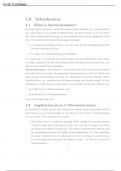
THERMODYNAMICS INTRODUCTION
The document introduces thermodynamics, focusing on its core principles and significance in science and engineering. It covers basic concepts such as systems, surroundings, states, and processes, along with key terms like energy, work, and heat. The notes outline the four fundamental laws of thermodynamics, providing a foundation for understanding energy transformations and conservation. Practical applications in various fields, from engines to environmental science, demonstrate thermodynamics'...
- Book
- Summary
- • 6 pages •
The document introduces thermodynamics, focusing on its core principles and significance in science and engineering. It covers basic concepts such as systems, surroundings, states, and processes, along with key terms like energy, work, and heat. The notes outline the four fundamental laws of thermodynamics, providing a foundation for understanding energy transformations and conservation. Practical applications in various fields, from engines to environmental science, demonstrate thermodynamics'...
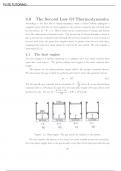
SECOND LAW OF THERMODYNAMICS
The document provides detailed notes on the Second Law of Thermodynamics, which states that entropy in an isolated system always increases over time. It explains that energy spontaneously spreads from regions of higher concentration to lower concentration, making processes irreversible. Key concepts include entropy, the direction of natural processes, and the inefficiency of energy conversions. Practical examples and applications in engines and refrigerators illustrate the law's significance in...
- Book
- Summary
- • 14 pages •
The document provides detailed notes on the Second Law of Thermodynamics, which states that entropy in an isolated system always increases over time. It explains that energy spontaneously spreads from regions of higher concentration to lower concentration, making processes irreversible. Key concepts include entropy, the direction of natural processes, and the inefficiency of energy conversions. Practical examples and applications in engines and refrigerators illustrate the law's significance in...
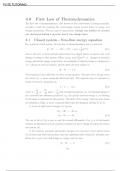
First Law of thermodynamics
The document contains concise notes on the First Law of Thermodynamics, emphasizing energy conservation in isolated systems. It outlines how energy cannot be created or destroyed, only transformed between forms. The document includes mathematical formulations, such as ΔU = Q - W, where ΔU represents the change in internal energy, Q is heat added, and W is work done by the system. Practical examples and applications in real-world scenarios are also highlighted.
- Book
- Summary
- • 7 pages •
The document contains concise notes on the First Law of Thermodynamics, emphasizing energy conservation in isolated systems. It outlines how energy cannot be created or destroyed, only transformed between forms. The document includes mathematical formulations, such as ΔU = Q - W, where ΔU represents the change in internal energy, Q is heat added, and W is work done by the system. Practical examples and applications in real-world scenarios are also highlighted.
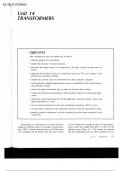
Transformers
Transformers are electrical devices that transfer electrical energy between circuits through electromagnetic induction. They consist of primary and secondary windings around a magnetic core, allowing voltage levels to be stepped up or down efficiently. Essential in power distribution, transformers enable the safe and efficient transmission of electricity over long distances, minimizing energy loss. Their ability to adjust voltage levels makes them crucial for various applications, from household...
- Book
- Class notes
- • 24 pages •
Transformers are electrical devices that transfer electrical energy between circuits through electromagnetic induction. They consist of primary and secondary windings around a magnetic core, allowing voltage levels to be stepped up or down efficiently. Essential in power distribution, transformers enable the safe and efficient transmission of electricity over long distances, minimizing energy loss. Their ability to adjust voltage levels makes them crucial for various applications, from household...
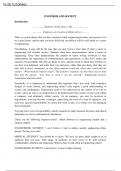
The Engineer And Society
Engineers play a pivotal role in society by applying scientific principles to develop innovative solutions to real-world problems. They design infrastructure, improve technology, and ensure safety and efficiency in various industries. By addressing societal needs, engineers contribute to economic growth, enhance quality of life, and drive sustainable development. Their work not only shapes the modern world but also anticipates future challenges, making engineers essential for societal progress a...
- Summary
- • 7 pages •
Engineers play a pivotal role in society by applying scientific principles to develop innovative solutions to real-world problems. They design infrastructure, improve technology, and ensure safety and efficiency in various industries. By addressing societal needs, engineers contribute to economic growth, enhance quality of life, and drive sustainable development. Their work not only shapes the modern world but also anticipates future challenges, making engineers essential for societal progress a...
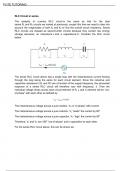
Series RLC Circuits
A series RLC circuit comprises a resistor (R), inductor (L), and capacitor (C) connected in a single path. The circuit's impedance depends on the frequency, with a characteristic resonance frequency where the inductive and capacitive reactances cancel each other. At resonance, the impedance is purely resistive, and the circuit can either attenuate or amplify signals. Series RLC circuits are crucial in applications like tuning, filtering, and signal processing in electrical and electronic system...
- Summary
- • 7 pages •
A series RLC circuit comprises a resistor (R), inductor (L), and capacitor (C) connected in a single path. The circuit's impedance depends on the frequency, with a characteristic resonance frequency where the inductive and capacitive reactances cancel each other. At resonance, the impedance is purely resistive, and the circuit can either attenuate or amplify signals. Series RLC circuits are crucial in applications like tuning, filtering, and signal processing in electrical and electronic system...
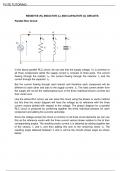
Parallel RLC Circuit
A parallel RLC circuit consists of a resistor (R), inductor (L), and capacitor (C) connected in parallel. It exhibits complex impedance behavior, combining resistive, inductive, and capacitive effects. The circuit's total impedance varies with frequency, leading to resonant behavior at a particular frequency where inductive and capacitive reactances cancel out. This makes parallel RLC circuits vital in tuning and filtering applications within communication and signal processing systems.
- Summary
- • 9 pages •
A parallel RLC circuit consists of a resistor (R), inductor (L), and capacitor (C) connected in parallel. It exhibits complex impedance behavior, combining resistive, inductive, and capacitive effects. The circuit's total impedance varies with frequency, leading to resonant behavior at a particular frequency where inductive and capacitive reactances cancel out. This makes parallel RLC circuits vital in tuning and filtering applications within communication and signal processing systems.
